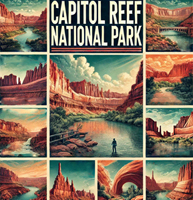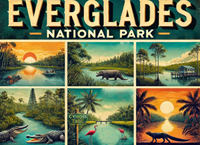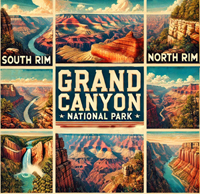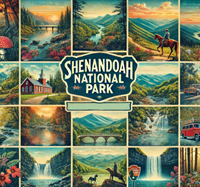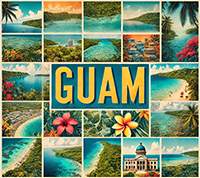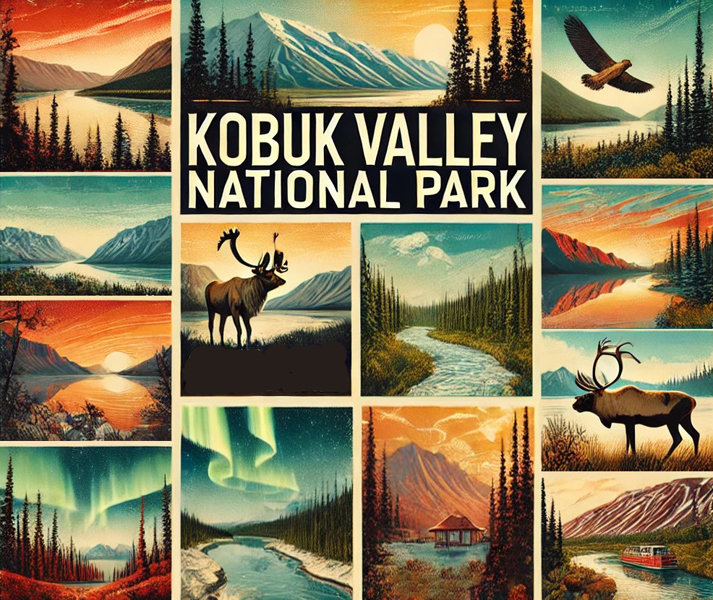

William and Hui Cha Stanek have meticulously crafted these national park guides, each showcasing the most stunning landscapes across the USA. But beyond the breathtaking scenery, these guides delve into the stories, experiences, and connections that make each park visit truly memorable.
National Parks Index | US Itineraries Index | American Roadtrips Index

Bring home a Bugville Critters book and watch as your child's love for reading and learning grows with every page. Hand-painted illustrations bring the heartwarming stories to life. Ask your librarian to add Bugville Critters to the library's digital collection today!
Discover William Stanek's Exclusive Art Collection
Explore and purchase the stunning art featured on this site. Own a piece of William Stanek's unique and captivating artwork today!
(October 29, 2024) Introducing Kobuk Valley National Park: Alaska's Remote Wilderness
Introduction to Kobuk Valley National Park
Kobuk Valley National Park is one of the most remote and least visited parks in the United States, offering a truly unique and untamed wilderness experience. The park' s most striking feature is the Great Kobuk Sand Dunes, a vast expanse of shifting sands set against the backdrop of the Arctic wilderness-- a sight that' s as unexpected as it is awe-inspiring. Visiting Kobuk Valley was like stepping into a different world, where the quiet stillness of the Arctic envelops you, and the vastness of the landscape reminds you of nature' s immense power. I' ll never forget the feeling of standing atop a dune, with nothing but the endless horizon stretching out before me. Kobuk Valley is a place for those who seek solitude and a deep connection to the raw, unspoiled beauty of the Arctic.
How to Reach Kobuk Valley National Park
From the North (Kotzebue, AK): Travelers can fly from Kotzebue to the park. There are no roads leading to the park, so access is typically by small plane or boat.
From the South (Anchorage, AK): Visitors can fly from Anchorage to Kotzebue or Bettles, then charter a flight into the park. This journey covers approximately 550 miles by air.
From the East (Fairbanks, AK): From Fairbanks, travelers can fly to Bettles, then charter a flight to the park. This route covers approximately 450 miles by air.
From the West (Nome, AK): Travelers from Nome can fly to Kotzebue, then charter a flight into the park. This journey spans around 280 miles by air.
Exploring Kobuk Valley: Must-Visit Sites
- Great Kobuk Sand Dunes: Some of the largest sand dunes in the Arctic, offering a unique landscape for exploration.
- Kobuk River: A major river providing opportunities for boating and wildlife viewing.
- Onion Portage: A historic site where caribou cross the river, significant for native I upiat culture.
- Baird Mountains: Rugged mountains offering scenic vistas and hiking opportunities.
Seasonal Variations
Kobuk Valley's remote location means it offers beauty in all seasons:
- Spring: Melting snow and ice create opportunities for wildlife viewing.
- Summer: Long daylight hours and milder temperatures make for ideal hiking and river trips.
- Fall: The caribou migration offers a unique wildlife spectacle.
- Winter: Extreme cold and snow provide a stark and beautiful landscape, perfect for those seeking solitude.
Visitor Updates for Kobuk Valley National Park
Conservation Efforts
William Stanek's photography in Kobuk Valley emphasizes the park's remote beauty and the importance of preserving its untouched wilderness. His work highlights the need for protecting the park's unique ecosystems and cultural heritage from the impacts of climate change and development.
1 Day at Kobuk Valley National Park: Alaska's Remote Wilderness
Introduction
Kobuk Valley National Park, located in northwestern Alaska, is known for its remote and pristine wilderness, including the Great Kobuk Sand Dunes and the Kobuk River. Here's a detailed guide to making the most of your visit, with expert tips from William and Hui Cha Stanek.
Morning: Arrival and Exploration
7:00 AM - Breakfast in Kotzebue
- Overview: Start your day with a hearty breakfast in the nearby town of Kotzebue.
- Tips from William: Capture the morning light on the town's charming streets.
- Insights from Hui Cha: Enjoy a nutritious breakfast to fuel your day. Pick up some snacks and water for later.
8:00 AM - Flight to Kobuk Valley
- Overview: Take a bush plane flight from Kotzebue to Kobuk Valley National Park.
- Tips from William: Use a telephoto lens to capture aerial views of the tundra and mountains. The flight provides stunning perspectives.
- Insights from Hui Cha: Dress warmly and bring a camera. The flight is an adventure in itself, offering breathtaking views.
Mid-Morning: Sand Dunes and River Exploration
9:30 AM - Great Kobuk Sand Dunes
- Overview: Explore the Great Kobuk Sand Dunes, some of the largest active dunes in the Arctic.
- Tips from William: Use a wide-angle lens to capture the vastness of the dunes. The morning light provides excellent contrast and shadows.
- Insights from Hui Cha: The sand can get hot, so wear appropriate footwear. Bring plenty of water and take your time exploring.
11:00 AM - Hiking the Dunes
- Overview: Hike the sand dunes for stunning views and a unique experience.
- Tips from William: Capture the textures and patterns in the sand. Use a macro lens to photograph the unique flora and fauna.
- Insights from Hui Cha: The hike can be strenuous, so take breaks and stay hydrated. Enjoy the solitude and pristine environment.
Afternoon: River Exploration and Wildlife Viewing
12:30 PM - Picnic Lunch by the Kobuk River
- Overview: Enjoy a packed lunch by the Kobuk River, with stunning views of the surrounding wilderness.
- Tips from William: Capture candid moments of your picnic with the beautiful river backdrop.
- Insights from Hui Cha: Pack a nutritious and energizing meal. Take a moment to relax and enjoy the natural surroundings.
1:30 PM - Canoeing on the Kobuk River
- Overview: Rent a canoe and paddle along the Kobuk River, offering unique perspectives of the park.
- Tips from William: Use a waterproof camera to capture the river's scenery. The afternoon light enhances the colors of the water and forest.
- Insights from Hui Cha: Wear a life jacket and bring water. Paddle quietly to increase your chances of spotting wildlife.
3:00 PM - Wildlife Viewing
- Overview: Spend some time looking for wildlife along the river and in the surrounding forest.
- Tips from William: Use a telephoto lens to capture distant wildlife. The late afternoon light is ideal for photography.
- Insights from Hui Cha: Be patient and respect the animals' space. The area is home to a variety of wildlife, including caribou and bears.
Late Afternoon: Photography and Relaxation
4:30 PM - Onion Portage
- Overview: Visit Onion Portage, a historic site along the Kobuk River known for its archaeological significance.
- Tips from William: Use a wide-angle lens to capture the landscape and historical features. Experiment with different compositions and perspectives.
- Insights from Hui Cha: This is a perfect spot to relax and take in the scenery. Bring a snack and enjoy the view.
Evening: Return and Dinner
6:00 PM - Return Flight to Kotzebue
- Overview: Take the return flight to Kotzebue, enjoying the scenic views once more.
- Tips from William: Capture the evening light on the tundra and mountains. Use a telephoto lens for detailed shots.
- Insights from Hui Cha: Enjoy the peaceful flight and reflect on the day's adventures. Keep an eye out for wildlife from the air.
7:30 PM - Dinner in Kotzebue
- Overview: Enjoy a relaxing dinner at a local restaurant in Kotzebue.
- Tips from William: Capture the evening atmosphere of the small town. Try some local Alaskan cuisine to end your day.
- Insights from Hui Cha: Reflect on the day's adventures and enjoy a hearty meal. Kotzebue offers a variety of dining options with a rustic charm.
Kobuk Valley National Park (Alaska)
Kobuk Valley National Park, located in northwestern Alaska, is one of the most remote and least visited national parks in the United States. The park is known for its vast sand dunes, the Kobuk River, and its rich cultural history with the native I upiat people. Covering over 1.7 million acres, Kobuk Valley offers a pristine wilderness experience for those seeking solitude and adventure.
Park History and Cultural Significance:
- Established as a national park in 1980, Kobuk Valley protects the unique geological and ecological features of the area.
- The park is significant to the native Inupiat people, who have lived in the region for thousands of years and rely on the migration of caribou for subsistence.
Visitor Centers and Facilities:
- Northwest Arctic Heritage Center: Located in Kotzebue, it serves as the visitor center for Kobuk Valley National Park, offering exhibits, maps, information, restrooms, and a gift shop.
- Campgrounds: There are no developed campgrounds within the park. Backcountry camping is available.
Best Times to Visit:
- Summer (June to August): The best time to visit with long daylight hours, moderate temperatures, and accessible river conditions.
- Fall (September to October): Cooler temperatures and the caribou migration are highlights, though the weather can be unpredictable.
- Winter (November to April): Offers solitude and opportunities for winter activities like snowshoeing and dog sledding, but temperatures can be extremely cold.
- Spring (May): Snow begins to melt, but access can be challenging due to muddy conditions and melting ice.
Activities and Recreation:
- Hiking and Backpacking: The park offers vast wilderness for backcountry hiking and exploration, with no designated trails.
- Caribou Migration: Witness the migration of caribou across the Kobuk River and the Great Kobuk Sand Dunes.
- Sand Dunes: Explore the Great Kobuk Sand Dunes, one of the largest dune fields in the Arctic.
- Wildlife Watching: Opportunities to see caribou, grizzly bears, wolves, and a variety of bird species.
- River Trips: Float trips on the Kobuk River offer a unique way to experience the park's remote wilderness.
Accessibility Information:
- The Northwest Arctic Heritage Center in Kotzebue is wheelchair accessible.
- Access to the park itself can be challenging for those with mobility issues due to the remote and rugged terrain.
Permits and Regulations:
- Entrance Fees: There is no entrance fee for Kobuk Valley National Park.
- Camping Permits: Not required for backcountry camping, but visitors are encouraged to register their trip.
- Backcountry Permits: Not required, but it is recommended to register your trip at the Northwest Arctic Heritage Center.
- Special Use Permits: Needed for activities such as commercial filming and large group gatherings.
Important Updates for Kobuk Valley National Park
Kobuk Valley National Park (Alaska)
Local Attractions and Surrounding Areas:
Kobuk Valley National Park, located in northwestern Alaska, is known for its remote wilderness, stunning sand dunes, and abundant wildlife. The nearby village of Kotzebue serves as a primary gateway to the park, providing basic amenities including lodging, dining, and transportation. Kotzebue is home to the Northwest Arctic Heritage Center, which offers exhibits and information about the park's natural and cultural history.
Further afield, the city of Fairbanks offers additional amenities and attractions, including the University of Alaska Museum of the North, the Fairbanks Ice Museum, and the historic downtown area. Fairbanks also serves as a gateway to the nearby Arctic National Wildlife Refuge, which offers additional opportunities for hiking, wildlife viewing, and exploring the region's stunning landscapes.
This remote park, known for its sand dunes and wilderness, requires extensive preparation.
- Weather: Extreme temperatures and weather conditions are common. Be prepared for hot days and cold nights.
- Navigation: No marked trails. Proficiency with maps, compasses, and GPS is essential.
- Isolation: Extremely remote with no facilities. Be self-sufficient and prepared for emergencies.
- Wildlife: Bears and other wildlife are present. Carry bear spray and store food properly.
- Permits: Required for overnight camping. Notify park authorities of your plans.
Nearby Attractions
Kobuk Valley National Park is surrounded by numerous attractions that enhance the visitor experience. Here are some must-see local attractions:
-
Great Kobuk Sand Dunes: One of the most unique features of the park, these massive sand dunes cover 25 square miles and can reach heights of up to 100 feet. The dunes provide a striking contrast to the surrounding tundra and offer excellent opportunities for photography and exploration.
-
Kobuk River: Flowing through the heart of the park, the Kobuk River is a major feature that supports a variety of wildlife and offers opportunities for boating, fishing, and wildlife viewing.
-
Onion Portage: A significant archaeological site along the Kobuk River, Onion Portage has been used by indigenous peoples for thousands of years as a hunting and fishing ground. It offers insights into the region's rich cultural history.
-
Salmon River: Known for its clear waters and abundant fish, the Salmon River is a great spot for fishing and wildlife viewing.
-
Walker Lake: Located near the park, Walker Lake is a stunning alpine lake surrounded by mountains, offering opportunities for boating, fishing, and camping.
Nearby Towns and Cities
Visitors to Kobuk Valley National Park can find additional amenities and activities in nearby towns and cities:
-
Kotzebue, Alaska: The primary gateway to Kobuk Valley National Park, Kotzebue offers accommodations, dining, and access to flights into the park. Attractions in Kotzebue include the Northwest Arctic Heritage Center and local cultural tours.
-
Noorvik, Alaska: Located near the Kobuk River, Noorvik is a small village that provides a glimpse into the local indigenous culture and lifestyle.
-
Bettles, Alaska: Another access point for the park, Bettles offers accommodations, guided tours, and flights to the park.
-
Anchorage, Alaska: Although further away, Anchorage serves as the main transportation hub for getting to Kotzebue. Anchorage offers a wide range of accommodations, dining, shopping, and attractions such as the Alaska Native Heritage Center and the Anchorage Museum.
Scenic Drives
Due to Kobuk Valley National Park's remote location and lack of road infrastructure, scenic drives within the park are not possible. However, the journey to the park via air offers breathtaking views of Alaska's rugged landscapes. Here are some scenic routes in the nearby areas that provide beautiful vistas and enhance the overall experience:
-
Dalton Highway (Fairbanks to Deadhorse):
- Details: This 414-mile scenic drive, also known as the Haul Road, offers stunning views of the Alaskan wilderness, including mountains, rivers, and tundra.
- Key Stops: Highlights include the Arctic Circle, the Yukon River, and the Brooks Range.
- Photography Tips: William Stanek suggests stopping at the various overlooks along the highway to capture the changing landscapes and wildlife. Early morning and late afternoon provide the best lighting for photography.
-
Seward Peninsula Drive (Nome to Teller):
- Details: This scenic drive on the Seward Peninsula offers beautiful coastal views and access to remote villages and historic sites.
- Key Stops: Highlights include Nome, the Bering Land Bridge National Preserve, and the village of Teller.
- Photography Tips: Hui Cha Stanek recommends using a wide-angle lens to capture the expansive landscapes and a telephoto lens for wildlife photography. The best times for photography are during the golden hours of sunrise and sunset.
River Routes:
-
Kobuk River: While there are no traditional scenic drives in Kobuk Valley National Park due to its remote location, the Kobuk River offers a stunning waterway route that takes visitors through the heart of the park, offering beautiful views of the surrounding mountains, sand dunes, and lush forests. Key stops along the river include the Great Kobuk Sand Dunes, the Onion Portage, and the Walker Lake. William recommends this river route for its breathtaking vistas and opportunities to explore the park's remote wilderness.
-
Noatak River: Another stunning waterway route in the region is the Noatak River, which offers beautiful views of the surrounding mountains, valleys, and lush vegetation. The river provides access to several recreational areas and viewpoints. Key stops along the river include the Noatak Village, the Anigaaq, and the views of the Brooks Range. Hui Cha highlights this river route for its serene beauty and the chance to explore the region's diverse landscapes.
Reservations and Timed Entry Information
Click the link to see updates. Wait up to 30 seconds for results.
Best Hikes
Kobuk Valley National Park offers vast opportunities for backcountry hiking and exploration. Due to the park's remote nature, there are no established trails, so hikers should be experienced and well-prepared for wilderness travel. Visitors should carry appropriate gear, navigation tools, and be aware of the challenges posed by the rugged terrain and wildlife. With this said, here are some of the best hikes in the park for Prepared Hikers:
-
Great Kobuk Sand Dunes Trail:
- Details: This trail leads into the heart of the Great Kobuk Sand Dunes, offering stunning views of the dunes and the surrounding landscape. The hike is moderately strenuous due to the sandy terrain.
- Key Viewpoints: Highlights include the expansive views from the top of the dunes and the striking contrast between the sand and the tundra.
- Photography Tips: William Stanek recommends visiting early in the morning or late afternoon to capture the best light and shadows on the dunes. A wide-angle lens is ideal for capturing the vastness of the dunes.
-
Kobuk River Trail:
- Details: This trail follows the Kobuk River, offering beautiful views of the river, forest, and opportunities for wildlife viewing. The trail is moderately easy.
- Key Viewpoints: Highlights include the views of the Kobuk River and the surrounding wilderness.
- Photography Tips: Hui Cha Stanek suggests using a telephoto lens to capture wildlife along the river and a wide-angle lens for the landscape shots. Early morning and late afternoon provide the best light for photography.
-
Onion Portage Trail:
- Details: This trail leads to the Onion Portage archaeological site, offering insights into the region's cultural history and stunning views of the Kobuk River. The hike is relatively easy.
- Key Viewpoints: Highlights include the archaeological site, the views of the Kobuk River, and the surrounding forest.
- Photography Tips: The Staneks recommend using a polarizing filter to enhance the colors of the landscape and a wide-angle lens to capture the expansive views. Early morning and late afternoon provide the best light for photography.
-
Salmon River Trail:
- Details: This trail follows the Salmon River, offering excellent opportunities for fishing and wildlife viewing. The trail is moderately easy.
- Key Viewpoints: Highlights include the views of the Salmon River and the surrounding wilderness.
- Photography Tips: William Stanek suggests using a telephoto lens to capture wildlife along the river and a wide-angle lens for the landscape shots. Early morning and late afternoon provide the best light for photography.
-
Walker Lake Trail:
- Details: This trail leads to Walker Lake, offering stunning views of the lake and the surrounding mountains. The hike is moderately strenuous.
- Key Viewpoints: Highlights include the views of Walker Lake and the surrounding forest.
- Photography Tips: Hui Cha Stanek recommends using a polarizing filter to enhance the colors of the lake and a wide-angle lens to capture the expansive views. Early morning and late afternoon provide the best light for photography.
Back Country Hiking: Navigating in Kobuk Valley National Park
In Kobuk Valley National Park, there are indeed no established trails, including the Great Kobuk Sand Dunes Trail, etc. Hikers must rely on navigation tools such as maps, compasses, and GPS devices to find and follow their intended routes. Here's how hikers typically navigate and explore the park:
-
Pre-Trip Planning:
- Research and Maps: Hikers should thoroughly research their route before heading out. Detailed topographic maps and GPS coordinates are essential. The National Park Service (NPS) and other reputable sources provide valuable maps and information.
- Weather and Conditions: Check the weather forecast and understand the seasonal conditions. The weather can change rapidly in remote Alaskan wilderness.
- Permits and Regulations: Ensure that all necessary permits are obtained and familiarize yourself with park regulations and safety guidelines.
-
Navigation Tools:
- Map and Compass: A topographic map and a reliable compass are crucial. Hikers should be proficient in orienteering skills to navigate the vast, trail-less wilderness.
- GPS Device: While a GPS device can be extremely helpful, it should not be relied upon solely. Batteries can die, and signals can be lost, so it's essential to have backup navigation methods.
- Satellite Phone or Personal Locator Beacon (PLB): Given the park's remoteness, carrying a satellite phone or PLB is advisable for emergency communication.
-
Landmarks and Natural Features:
- Landmarks: Use natural landmarks such as rivers, mountains, and the sand dunes themselves to navigate. The Great Kobuk Sand Dunes are a significant and visible landmark within the park.
- Rivers and Valleys: Rivers like the Kobuk River can be used as natural guides for orientation and travel.
- Geographical Features: Pay attention to geographical features and use them for navigation, especially in areas with no distinct landmarks.
-
Safety and Preparation:
- Travel in Groups: It's safer to hike in groups. If something goes wrong, having companions increases the chances of a successful resolution.
- First Aid and Survival Gear: Carry a comprehensive first aid kit, survival gear, and enough food and water for the duration of the trip plus extra for emergencies.
- Leave a Trip Plan: Inform someone about your trip plan, including your intended route and expected return time. This is crucial for your safety in case of an emergency.
Other Hikes for Prepared Hikers:
-
Akabluak Pass Trail: This challenging multi-day hike takes hikers through the scenic Akabluak Pass, offering stunning views of the surrounding peaks, valleys, and rivers. The trail features diverse vegetation, rugged terrain, and beautiful vistas. Key points of interest along the trail include the Akabluak Pass, the John River, and the views of the Brooks Range. Hui Cha recommends this hike for experienced hikers looking for a challenging adventure and breathtaking views.
-
Itkillik Valley Trail: This challenging multi-day hike takes hikers through the scenic Itkillik Valley, offering stunning views of the surrounding mountains, valleys, and rivers. The trail features diverse vegetation, lush meadows, and beautiful vistas. Key points of interest along the trail include the Itkillik River, the Howard Pass, and the views of the Brooks Range. William suggests this hike for experienced hikers looking for a rewarding adventure and stunning views.
-
Agashashok River Trail: This challenging multi-day hike takes hikers through the scenic Agashashok River Valley, offering stunning views of the surrounding peaks, valleys, and rivers. The trail features diverse vegetation, rugged terrain, and beautiful vistas. Key points of interest along the trail include the Agashashok River, the Howard Pass, and the views of the Brooks Range. Hui Cha highlights this hike for experienced hikers looking for a rewarding adventure and breathtaking views.
-
Noatak River Trail: This challenging multi-day hike takes hikers along the scenic Noatak River, offering stunning views of the surrounding mountains, valleys, and rivers. The trail features diverse vegetation, lush meadows, and beautiful vistas. Key points of interest along the trail include the Noatak River, the Howard Pass, and the views of the Brooks Range. William recommends this hike for experienced hikers looking for a rewarding adventure and stunning views.
William and Hui Cha Stanek emphasize the importance of preparation and respect for the wilderness when exploring parks like Kobuk Valley. Their photography expeditions often involve extensive planning and a deep understanding of the natural environment. They advocate for responsible and safe exploration, highlighting the need for adequate preparation, respect for nature, and awareness of the challenges posed by such remote and wild areas.
Conclusion
Kobuk Valley National Park, with its dramatic landscapes and unique geological features, offers endless opportunities for exploration and photography. The park's local attractions, nearby towns, and hiking trails provide a comprehensive and immersive experience. Through the lens of William and Hui Cha Stanek, the park's natural wonders and significance are vividly captured, inspiring a deeper appreciation and commitment to preserving this unique national treasure. Whether you're a seasoned photographer or a casual explorer, Kobuk Valley National Park promises a memorable and enriching adventure.

Step into a world of timeless beauty with our premium, oversized hardcover book - crafted for discerning collectors and anyone who values the power of art. Perfect for your coffee table, it's more than just a book; it's a conversation starter, a window into over 30 years of William's visionary photography.
Your Support Matters
Purchasing artwork from William Stanek's collection not only brings beauty into your life but also helps us continue to share. Thank you for supporting our creative journey!

Support The Lights of Paris by Robert Stanek, William Stanek's pen name! Through vivid historical detail and deeply moving character stories, Robert takes readers on an unforgettable journey through one of history’s most transformative times.




